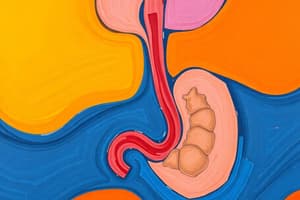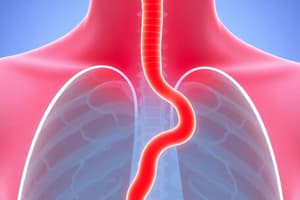Podcast
Questions and Answers
Which of the following is NOT part of the classical triad associated with esophageal issues?
Which of the following is NOT part of the classical triad associated with esophageal issues?
- Weight Loss
- Chest Pain (correct)
- Dysphagia
- Regurgitation
The most common complication of esophageal issues is aspiration pneumonia.
The most common complication of esophageal issues is aspiration pneumonia.
True (A)
What is the major feature that distinguishes Achalasia II from Achalasia I?
What is the major feature that distinguishes Achalasia II from Achalasia I?
Presence of pan esophageal pressurization in ≥ 20% swallows.
The scoring system that assesses esophageal symptoms is called the ________ Score.
The scoring system that assesses esophageal symptoms is called the ________ Score.
Match the type of achalasia with its description:
Match the type of achalasia with its description:
Which of the following is true regarding the indications for using Botox in gastrointestinal surgery?
Which of the following is true regarding the indications for using Botox in gastrointestinal surgery?
The risk of perforation during balloon dilation is higher with balloons larger than 30 mm.
The risk of perforation during balloon dilation is higher with balloons larger than 30 mm.
What is the primary complication associated with Heller's myotomy?
What is the primary complication associated with Heller's myotomy?
In achalasia Type 2, the best management option is __________.
In achalasia Type 2, the best management option is __________.
Match the types of achalasia with their best management options:
Match the types of achalasia with their best management options:
What is the most common symptom associated with Zenker's Diverticulum?
What is the most common symptom associated with Zenker's Diverticulum?
Zenker's Diverticulum is also known as crico-pharyngeal achalasia.
Zenker's Diverticulum is also known as crico-pharyngeal achalasia.
Name one of the surgical management options indicated for large (>2 cm) symptomatic Zenker's Diverticulum.
Name one of the surgical management options indicated for large (>2 cm) symptomatic Zenker's Diverticulum.
The most common complication of Zenker's Diverticulum is ________ pneumonia.
The most common complication of Zenker's Diverticulum is ________ pneumonia.
Match the following clinical features with their description related to Zenker's Diverticulum:
Match the following clinical features with their description related to Zenker's Diverticulum:
What is the primary clinical feature of Schatzki Ring?
What is the primary clinical feature of Schatzki Ring?
Dysphagia Lusoria is caused by compression from an aberrant left subclavian artery.
Dysphagia Lusoria is caused by compression from an aberrant left subclavian artery.
What diagnostic investigation is typically used for Schatzki Ring?
What diagnostic investigation is typically used for Schatzki Ring?
Schatzki Ring is defined as a _____ > _____ ring.
Schatzki Ring is defined as a _____ > _____ ring.
Match the following terms with their descriptions:
Match the following terms with their descriptions:
What is the primary goal of treatment in gastrointestinal and abdominal surgery related to eosinophilia?
What is the primary goal of treatment in gastrointestinal and abdominal surgery related to eosinophilia?
What type of esophageal cancer is most commonly found in the lower third of the esophagus?
What type of esophageal cancer is most commonly found in the lower third of the esophagus?
The primary goal of treating eosinophilia is to increase the eosinophil count in the body.
The primary goal of treating eosinophilia is to increase the eosinophil count in the body.
Squamous cell carcinoma has a strong association with hot beverages.
Squamous cell carcinoma has a strong association with hot beverages.
What is the key focus of treatment in gastrointestinal surgery concerning eosinophilia?
What is the key focus of treatment in gastrointestinal surgery concerning eosinophilia?
The treatment goal in gastrointestinal and abdominal surgery regarding eosinophilia is to ________ eosinophilia.
The treatment goal in gastrointestinal and abdominal surgery regarding eosinophilia is to ________ eosinophilia.
Which dietary deficiency is linked to an increased risk of squamous cell carcinoma?
Which dietary deficiency is linked to an increased risk of squamous cell carcinoma?
Match the terms with their descriptions:
Match the terms with their descriptions:
Obesity is primarily a risk factor for ________ esophageal carcinoma.
Obesity is primarily a risk factor for ________ esophageal carcinoma.
Match the risk factor with its associated esophageal cancer type:
Match the risk factor with its associated esophageal cancer type:
Which of the following is NOT a risk factor for adenocarcinoma?
Which of the following is NOT a risk factor for adenocarcinoma?
Chewing betel nut is associated with an increased risk of adenocarcinoma.
Chewing betel nut is associated with an increased risk of adenocarcinoma.
List one risk factor for adenocarcinoma that is not a risk factor for squamous cell carcinoma.
List one risk factor for adenocarcinoma that is not a risk factor for squamous cell carcinoma.
What is a key feature of Mackler's triad?
What is a key feature of Mackler's triad?
Boerhaave syndrome typically presents with upper gastrointestinal hemorrhage.
Boerhaave syndrome typically presents with upper gastrointestinal hemorrhage.
What imaging study is preferred for a stable patient suspected of having esophageal perforation?
What imaging study is preferred for a stable patient suspected of having esophageal perforation?
A __________ is a split in the mucosa & submucosal layers associated with a Mallory Weiss tear.
A __________ is a split in the mucosa & submucosal layers associated with a Mallory Weiss tear.
Match the following conditions with their respective characteristics:
Match the following conditions with their respective characteristics:
What is the most common type of hiatal hernia?
What is the most common type of hiatal hernia?
A rolling hiatal hernia requires surgical management in all patients.
A rolling hiatal hernia requires surgical management in all patients.
What is the primary clinical feature associated with a sliding hiatal hernia?
What is the primary clinical feature associated with a sliding hiatal hernia?
The most common congenital diaphragmatic hernia is called the __________ hernia.
The most common congenital diaphragmatic hernia is called the __________ hernia.
Match the type of hiatal hernia with its respective characteristics:
Match the type of hiatal hernia with its respective characteristics:
What is the primary management strategy for a Type III hernia?
What is the primary management strategy for a Type III hernia?
Iatrogenic esophageal perforations are more common in the lower third of the esophagus.
Iatrogenic esophageal perforations are more common in the lower third of the esophagus.
What condition is also known as Boerhaave syndrome?
What condition is also known as Boerhaave syndrome?
In the case of an iatrogenic esophageal perforation, you should avoid using a ________ NG tube to prevent increased perforation risk.
In the case of an iatrogenic esophageal perforation, you should avoid using a ________ NG tube to prevent increased perforation risk.
Match the following terms with their descriptions:
Match the following terms with their descriptions:
Which of the following features characterizes Distal Esophageal Spasm (DES)?
Which of the following features characterizes Distal Esophageal Spasm (DES)?
Barium swallow can show a 'rosary bead' appearance in patients with DES.
Barium swallow can show a 'rosary bead' appearance in patients with DES.
What is the primary treatment that shows a very good response for Distal Esophageal Spasm?
What is the primary treatment that shows a very good response for Distal Esophageal Spasm?
The type of diverticulum located in the upper esophagus is known as __________.
The type of diverticulum located in the upper esophagus is known as __________.
What is a common feature in patients presenting with esophageal motility disorders?
What is a common feature in patients presenting with esophageal motility disorders?
Match the types of esophageal diverticula with their locations:
Match the types of esophageal diverticula with their locations:
Endoscopy is a diagnostic procedure used to investigate both achalasia and esophageal cancer.
Endoscopy is a diagnostic procedure used to investigate both achalasia and esophageal cancer.
List one potential cause of Zenker's diverticulum.
List one potential cause of Zenker's diverticulum.
Flashcards are hidden until you start studying
Study Notes
Schatzki Ring
- Mucosal or submucosal ring in the lower esophagus.
- Causes intermittent, non-progressive dysphagia.
- Diagnosed with barium swallow.
- Managed with symptomatic treatment or balloon dilation.
Dysphagia Lusoria
- Esophageal compression from an aberrant right subclavian artery.
Achalasia
- Classical Triad: Dysphagia (initially liquids, then solids), weight loss, regurgitation.
- Other Symptoms: Heartburn, nocturnal cough, post-prandial choking.
- Complications: Aspiration pneumonia (most common), lung abscess.
- Investigations: Manometry (increased lower esophageal sphincter pressure, failure of relaxation), endoscopy (to rule out cancer), barium swallow.
- Chicago Classification: Categorizes achalasia based on manometric findings (peristalsis, lower esophageal sphincter pressure).
- Achalasia-Eckardt Score: 4-parameter scoring system (weight loss, dysphagia, retrosternal pain, regurgitation) for severity assessment.
- Management: Botox injections (effective but high recurrence, best for elderly with comorbidities), pneumatic dilation (effective, risk of perforation reduced with balloon <30mm, best responders: age >45, female, previously undilated esophagus, Type A achalasia), Heller’s myotomy (surgical, best for Type 1), POEM (peroral endoscopic myotomy, best for Type 3 and spastic conditions), Heller's myotomy + pneumatic dilation (Type 2 achalasia). Heller's myotomy may cause GERD, which can be prevented with fundoplication. POEM has a higher risk of GERD.
Distal Esophageal Spasm (DES)
- Less common than achalasia; females > males.
- Motor abnormality of the lower two-thirds of the esophageal body.
- High-amplitude, repetitive, simultaneous contractions.
- Diagnosed with ECG (to rule out angina), barium swallow (rosary bead/corkscrew appearance), and manometry.
- Treated with POEM or calcium channel blockers/nitrates.
Approach to Motility Disorders
- Consider achalasia, cancer, DES, and angina in the differential diagnosis. Workup depends on the suspected condition and includes endoscopy, manometry, barium swallow, and ECG.
Esophageal Diverticula
- Zenker's (pharyngoesophageal): Pulsion diverticulum, usually false, located in the upper esophagus; associated with increased risk of squamous cell carcinoma. Management includes diverticulectomy and cricopharyngeal myotomy for symptomatic, large diverticula (>2cm).
- Mid-esophageal (para-bronchial): Traction diverticula.
- Lower esophageal (epiphrenic): Pulsion diverticula, often false.
Esophageal Cancers
- Squamous cell carcinoma (SCC): More common globally, often associated with smoking, alcohol, hot beverages, N-nitroso compounds, chewing betel nut.
- Adenocarcinoma: More common in Western world; associated with obesity, GERD, Barrett's esophagus.
- Risk factors vary based on the type of esophageal cancer (see table).
Zenker's Diverticulum
- Also known as cricopharyngeal achalasia.
- Outpouching through Killian's triangle.
- Early symptom is regurgitation, followed by halitosis and dysphagia.
- Aspiration pneumonia is a major complication.
- Diagnosed with barium swallow.
- Large or symptomatic diverticula are managed surgically with diverticulectomy and cricopharyngeal myotomy.
Other Hernias
- Type III: Mixed sliding and rolling hiatal hernia. Management depends on the rolling component.
- Type IV: Paraesophageal hernia with content other than the stomach.
Esophageal Perforation
-
Iatrogenic (post-endoscopy): Most common in the upper third; risk factors include therapeutic endoscopy, lack of skill, and endoscopic procedures in patients with cancer. Treatment depends on the stability of the perforation; stable patients with small perforations may be treated conservatively (NPO, IV fluids, antibiotics, pain management); unstable patients or those with large perforations might require endoscopic sealing or surgical repair.
-
Spontaneous (Boerhaave syndrome): Most common in the lower third (left posterolateral wall); usually involves vomiting against a closed glottis.
-
Mackler's triad: chest pain, retching, subcutaneous emphysema
-
Mallory-Weiss tear: Mucosal and submucosal layer split, typically in the upper GI tract; presents with upper GI bleeding.
-
Boerhaave syndrome: Perforation of the lower GI tract; presents with Mackler's triad (chest pain, retching, subcutaneous emphysema); Hamman's crunch (mediastinal crackling) may be auscultated.
-
Investigations: Stable patients: CECT. Unstable patients: Contrast study (Iohexol preferred over barium to avoid artifacts if leakage is present).
-
Treatment goals: Seal the perforation, drain fluid/pus and provide adequate nutrition.
Hiatal Hernia
- Sliding (Type I): Most common type; upward sliding of the gastroesophageal junction; usually asymptomatic or presents with GERD; managed symptomatically for smaller hernias; large hernias may require fundoplication.
- Rolling/Paraesophageal (Type II): Portion of the stomach herniates into the thoracic cavity; gastroesophageal junction remains normal; requires surgical repair to prevent volvulus/necrosis.
Studying That Suits You
Use AI to generate personalized quizzes and flashcards to suit your learning preferences.





